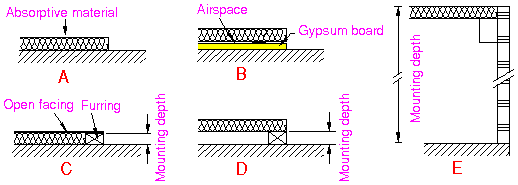
General Concepts

Pure tone wave has a frequency, therefore it must has wavelength which is the distance the sound travels in one cycle time. The higher the frequency is, the shorter the wavelength.
Sound Levels and
Decibel
The definitions of sound levels and decibel are related to the amplitude of the signal. The absolute value of the sound intensity
(I) can be described in Watts per square meter or W/m². As discussed above
for frequency, the change in the sound intensity (or
sound pressure level, SPL) must be more than a certain
value in order to be heard by the human hearing system.
The full range of the
audible sound intensity values can be divided into 100
ranges, the higher the sound intensity (louder the sound), the
wider the intensity range. Taking into account this human perception, the unit Bel is used. Bel is
the logarithm of the ratio of two power values. If, for example, intensity I=0.1 W/m² change to
1 W/m², the resulting sound level (note that the word "level" is added for logarithmic values)
will be 1 Bel considering 0.1 W/m² as the reference value (to take
the log). Hence the Bel unit is considerably large,
one tenth of it is used (the same concept as discussed above for more frequency resolution), and the
resulting unit is called decibel or (dB).
In sound
application the dB reference value is 20 μPa for sound
pressure or 10E-12 W/m² for sound intensity. These values
represent 0 dB sound level and the human
threshold of hearing (the lowest level that can be
perceived). The threshold of pain or feeling (the level which
causes pain in the ears) is about 120 dB as shown in the following drawing:

Note that the decibel values of sounds cannot be added to obtain the value of the resulting sound. Instead, the combining levels are turned into intensities, added together and then turned back into decibel values.
Sound level 1 dB + Sound level 2 dB dB
Sound Absorption
Coefficient
Sound absorption coefficient describes the efficiency of the material
or the surface to absorb the sound. The ratio of the
absorbed sound energy to the incident energy is the sound
absorption coefficient.
For architectural purposes, sound absorbing materials and constructions can
be divided into four types of materials depending on the way the absorption is mainly performed:
1-Turning
the sound energy into heat such as fiberglass and carpet.
2-Vibrating with a specific frequency when the sound
hits the surface such as lightweight panels and 5/8"
gypsum board. (These materials absorb the sound effectively on a narrow band of frequencies)
3-Turning the sound energy into heat in the neck of the cavities
(Helmholtz resonator) such as sound blocks (this construction has a good absorption on low frequencies).
4-Allowing the sound to go through such as some types of grid systems and
lay-in ceiling with sound leakage above it.
The most common way to measure sound absorption coefficient
is to lay a piece of the material in a reverberant
room (a room which has very long
Reverberation Time) then measure the RT so the coefficient
can be derived from Sabin equation
(the original version of RT calculation). There is a standard that
details this procedure.
The value of the absorption coefficient for the same material varies with
the type of the mounting in the test room.
Mounting types that are frequently given in
manufacturer's data sheets for the acoustical panels are illustrated in the
following drawing:

Noise reduction coefficient NRC is the arithmetic average of the sound absorption coefficients at 250, 500, 1000, and 2000 Hz, then this average is rounded to the multiples of 0.05.
Diffraction
Diffraction is the change in the
direction of the propagation of sound waves passing the edge of the
obstacle as illustrated in the following figure:
